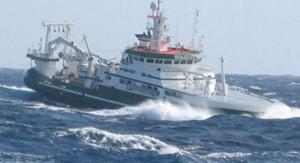Who needs Atlantis?

We don’t need to be inventing mythical islands in the Atlantic Ocean to make it interesting. There is a wealth of undiscovered biological phenomena off Ireland’s west coast which, until now, was yet to be looked into. Last week a group of Irish and English scientists set off in to the middle of the ocean, 3000 metres below sea level to the mid Atlantic ridge. John Holden reports.
The Atlantic Ocean has literally shaped the west coast of Ireland’s geography and therefore, history. Yet expeditions into the blue unknown are few and far between by marine experts. As such this uncharted territory could reveal all kinds of fascinating new species of life previously unseen.
The 25-day voyage, which left Galway last week will aim to do two things. Firstly they will use Holland 1, a remotely operated vehicle (ROV), to film the hydrothermal ecosystem. Following this other research into the cold-water coral Moira Mound reefs in the area will also be conducted.
On board the ship will be experts from Southampton’s National Oceanography Centre, UCC, NUI Galway and Duke University North Carolina, as well as a National Geographic film crew on board to film the mission for its Oceanus TV series.
Marine biologist Patrick Collins of the NUI Galway Ryan Institute will be on board the Celtic Explorer, the State’s national marine research vessel, for this “groundbreaking mission” to the mid Atlantic ridge. In the past he has described the mission as the “most technically challenging marine research ever undertaken by Ireland”.
“I’ll be looking for animals that live around deep sea hydro thermal vents,” he says. “These vents are cracks in the earth’s surface, where tectonic activity takes place under water. Magma reaching temperatures of up to 400C spew out of the seabed into the water. The magma is full of hydrogen sulphite and methane and heavy metals.”
Such a noxious fluid is toxic to most animals, but is heaven to chemotrophic bacteria. “In exactly the same way a plant utilises light through photosynthesis, chemotrophs thrive in a chemo-synthetic environment,” says Collins. Around these parts, such small bacteria form the basis of the food chain.
In fact, 3000 metres downwards along the mid Atlantic ridge, you’ll find mussels, shrimp, crab, worms and snails etc. “It’s hard to imagine how these animals can exist down there,” says Collins. In fact, due to the lack of predators, abundance of food (in the form of chemotrophic bacteria) and the creatures’ evolved ability to tolerate such a nasty environment, there is no competition and their populations have exploded. Anyone squeamish should stop reading now - some of these creatures can grow to gigantic proportions. Imagine worms one metre long and as thick as your wrist, or snails the size of tennis balls. “They’re almost identical to the ones we see on land except they’re ten times the size,” says Collins. “They have a symbiotic relationship with the bacteria.” These creatures harbour the chemotrophic bacteria in their gills, for example, and provide very safe environments. In return the creatures feed off them.
Anyone who has seen the movie The Abyss will be scarily aware of the possibilities of all manner of new-fangled creatures living among us. “It’s incredibly dark at 3000 metres below sea level,” says Collins. Obviously there’s no sunlight so interesting adaptations will be found. Because of the extreme heat being given off a lot of infra red light can be seen from the vents themselves. So some animals have evolved a third eye capable of seeing the red light.” In addition, bio-luminescence is used by corals to glow in the dark. “It’s amazing down there. The coral can light the colour of the whole ocean a fluorescent rainbow, not unlike the aurora borealis.”
Image top: Scientists@Sea
